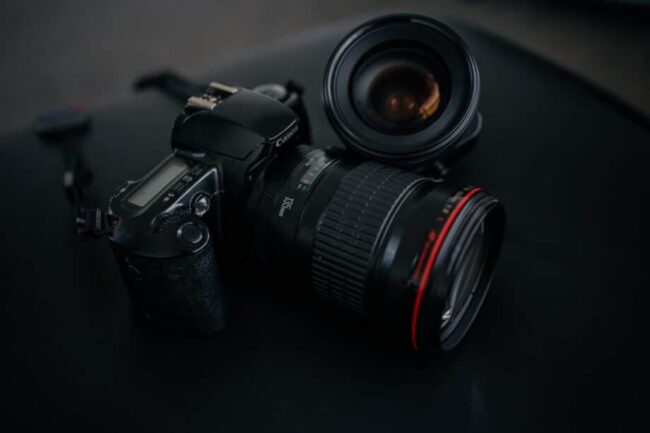What is a DSLR Camera?
Digital Single-Lens Reflex (DSLR) cameras utilize a method with roots tracing back to film photography. When light enters these cameras, it reflects off a mirror, moves through a prism, and then presents itself to the viewer’s eye through the viewfinder.
Table Of Contents
−- What is a DSLR Camera?
- Introduction to Mirrorless Cameras
- Size, Weight, and Handling
- Optical vs. Electronic Viewfinders: A Shift in Viewing
- Features and Modern Advancements
- Lens Variety and Choices
- Image Quality Considerations
- Video Capabilities
- Battery Life Considerations
- Autofocus Speed and Precision
- The Joy of Photography
- Cost and Value
- Conclusion
The specific movement of the mirror, flipping to expose the camera sensor to light, is a mechanical characteristic unique to the DSLR. However, this mechanism demands a more substantial design, which some users might find weighty.

Introduction to Mirrorless Cameras
Mirrorless cameras, evident from their name, do away with the traditional mirror mechanism. The light goes directly onto the digital sensor after passing through the lens, and the resulting image is either shown on the rear screen or an electronic viewfinder. This design not only reduces the camera’s size but also introduces both benefits and challenges for photographers.
Size, Weight, and Handling
DSLRs have traditionally been larger, signaling power and performance. This size is primarily due to the mirrors and prisms inside them. Mirrorless cameras, in contrast, began by offering photographers a more compact option without compromising much on the image’s quality.
But recently, high-end mirrorless models have become bulkier, indicating a shift based on ergonomic requirements.
Optical vs. Electronic Viewfinders: A Shift in Viewing
The difference between optical and electronic viewfinders extends beyond technology; it concerns the user experience. Purists often prefer the clear and direct view from optical viewfinders. Electronic ones, though, provide real-time exposure previews, digital information overlays, and focus aids.
As technology advances, the distinction between the two narrows, making it more about personal preference.
Features and Modern Advancements
Both camera types come loaded with features. However, mirrorless cameras have been quicker to integrate newer technologies. For instance, in-body image stabilization, present in a few DSLRs, is more common in mirrorless models. Still, the gap is narrowing as both types adopt advancements from each domain.
Lens Variety and Choices
DSLRs, having been around longer, have a broader range of available lenses. This history allows users to even employ vintage lenses on newer bodies. Mirrorless cameras, although newer, are rapidly expanding their lens options.
Companies like Sony and Fuji receive praise for their innovative optics, and adaptors enable the use of older DSLR lenses on mirrorless devices.
Image Quality Considerations
Previously, DSLRs were the primary choice for top-tier image quality. Now, mirrorless cameras, with their range of sensor sizes, often match or even exceed DSLR output. Factors such as color reproduction, sharpness, and low-light performance have become model-specific rather than based on the technology itself.
Video Capabilities
DSLRs were pioneers in introducing video functions in consumer cameras, but mirrorless models have taken the lead. They were quicker to standardize features like 4K recording and high frame rate shooting. Their compact size and minimized rolling shutter effects have also made them popular among videographers.
Battery Life Considerations
A traditional drawback of mirrorless cameras has been battery life. Their electronic viewfinders and screens consume more power, resulting in more frequent battery changes. DSLRs, relying on optical viewfinders, tend to last longer on a single charge. However, newer battery technology and better power management are helping bridge this difference.
Autofocus Speed and Precision
Pro-grade DSLRs are renowned for their fast autofocus, thanks to their phase-detection technology. While mirrorless cameras faced challenges in this area initially, recent models with hybrid autofocus systems are proving to be both quick and accurate.
The Joy of Photography
Photography isn’t just about specifications; it’s about emotion and expression. For many, DSLRs provide a nostalgic feeling, reminding them of older times. Others prefer the fresh and modern approach of mirrorless cameras.
Cost and Value
DSLRs traditionally provided more features at lower price points. However, as mirrorless technology has matured, the prices for these cameras have dropped, often offering great value, especially in the entry-level and mid-range segments.
Conclusion
The debate between DSLR and mirrorless is subjective. Both have their strengths, and the choice often comes down to individual needs and preferences. Today’s photographer benefits from a range of options, ensuring there’s a perfect camera out there for everyone.

Editorial Staff
Our writers, editors, content managers, and SEO specialist. We all take part in crafting amazing articles. We spend hours ensuring that each article is based on facts, researched, and thorough. You'll never want to click the back button to look for more answers other than here!
